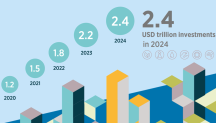
-
-
IRENA (2022), World Energy Transitions Outlook 2022: 1.5°C Pathway, International Renewable Energy Agency, Abu Dhabi
Copied
/-/media/Files/IRENA/Agency/Publication/2022/Mar/IRENA_World_Energy_Transitions_Outlook_2022.pdf
Copied
World Energy Transitions Outlook: 1.5°C Pathway
Newsletter
Download the Executive summary
Download Slides
The Executive Summary is also available in in Arabic (عربي), Chinese (中文), French (français), German (Deutsch), Italian (italiano), Japanese (日本語), Portuguese (Português), Russian (Русский) and Spanish (español).
In Paris in 2015, signatories to the United Nations Convention on Climate Change agreed to pursue efforts to try to limit the rise in global temperatures by 2050 to 1.5°C above pre-industrial levels. The World Energy Transitions Outlook presents a pathway to that goal, one that decarbonises all end uses, with electrification and energy efficiency as primary drivers, enabled by renewables, green hydrogen and sustainable modern bioenergy.
This second edition of the Outlook outlines priority areas and actions based on available technologies that must be realised by 2030 to achieve net zero emissions by mid-century.
By laying out a map for the next eight years, World Energy Transitions Outlook 2022 enables policy makers to stay on the path to 2050. The report provides in-depth analysis of two areas particularly relevant for the decarbonisation of end-use sectors: electrification and bioenergy. It also explores the socio-economic impacts of the 1.5°C pathway and suggests ways to speed progress towards universal access to clean energy.

Despite progress in recent years to move the power sector away from fossil fuels, other major energy-using sectors that are also highly reliant on fossil fuels, including transport, continue to contribute to emissions and perpetuate exposure to volatility in the prices of fossil fuels. The technological avenues leading to a decarbonised energy system are clear. They are dominated by solutions that can be deployed cost-efficiently, rapidly and at scale.
Only a holistic global policy framework can bring countries together to orchestrate a just transition that leaves no one behind and strengthens the international flow of finance, capacity and technologies.
Achieving the 2050 target depends on making rapid progress now.
See the visual story: How an accelerated transition to renewables can mitigate the energy and climate crisis?





